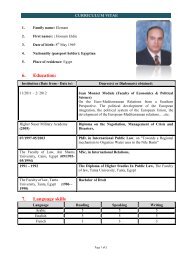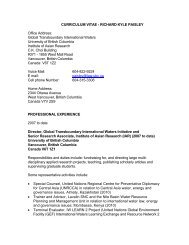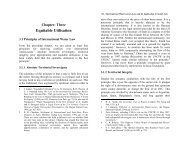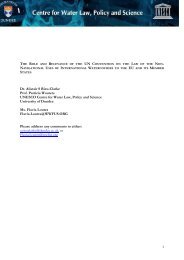Upreti, Trilochan, International Watercourses Law and Its Application ...
Upreti, Trilochan, International Watercourses Law and Its Application ...
Upreti, Trilochan, International Watercourses Law and Its Application ...
Create successful ePaper yourself
Turn your PDF publications into a flip-book with our unique Google optimized e-Paper software.
278 / <strong>International</strong> <strong>Watercourses</strong> <strong>Law</strong> <strong>and</strong> <strong>Its</strong> <strong>Application</strong> in South Asia Conclusions <strong>and</strong> Recummendations / 279Chapter- SixConclusions <strong>and</strong> Recummendations6.1 ConclusionsIn the earlier chapter, an analysis of IWL, <strong>and</strong> its application tothe water resources available in south Asia has been made.Each Chapter analysed the problems associated with realisingthe promising potential of the resources in a coherent manner.The study has indicated the significance of water, themagnitude of the problems, the manner in which they could beresolved, <strong>and</strong> the tremendous gains that would be realised fromthe judicious utilisation of these resources. Of the fourprinciples that have emerged in IWL, i.e. territorial sovereignty,territorial integrity, prior appropriation <strong>and</strong> equitable utilisation,I advocate the wider acceptance of the equitable utilisationprinciple. Equity, which is the central theme of this book, hasthe ability to accommodate every interest <strong>and</strong> create win-winsituations out of complicated conflicts between contestantstates <strong>and</strong> communities.6.2 Summary of FindingsThe first Chapter introduced the aims of this thesis <strong>and</strong> assessedthe significance of the water resources of Nepal <strong>and</strong> theirimmense potential for the prosperity of that country as well asher south Asian neighbours. As a regional power, India has agreat role to play but she must give attention to Nepal’sdevelopment in harmony with the norms of equity envisaged inArticles 5 <strong>and</strong> 6 of UNCIW. The best way to resolve waterconflicts is by negotiation rather than judicial settlement, 1 inline with a liberal approach of equity.1 B. R. Chauhan, Settlement of <strong>International</strong> Water <strong>Law</strong> Disputes in<strong>International</strong> Drainage Basins, Berlin: Eric Schmidt Verlag, 1981, p. 465.The present circumstance of confrontation between Nepal <strong>and</strong>India is not conducive to the enhancement of co-operation forequitable utilisation of water resources. For example, India hasconstructed a network of reservoirs <strong>and</strong> dams along the wholeIndo-Nepal border without giving prior notice to Nepal, therebyinundating huge areas of Nepalese territory. 2 No mitigation,elimination or compensation has been provided for such harm.This is a flagrant breach of IWL. 3 The study suggests that inorder to attain the maximum benefits for all the riparian states,international <strong>and</strong> regional cooperation is the first pre-condition.By doing so, poverty can be reduced, sustainable developmentundertaken; dependence within interdependence can be set out<strong>and</strong> the cloud of distrust can be converted into prosperity. 4Chapter two evaluated <strong>and</strong> demonstrated the long effortsexerted in the development <strong>and</strong> codification of IWL. There areseveral instruments that deserve universal application such asUNCIW. The exact application of those instruments, however,could vary depending upon the specific circumstances. Eachwatercourse has unique circumstances; 5 a resolution suitablefor each set of circumstances is highly desirable. Even thoughthe law is the same, it requires greater flexibility in the use ofdiscretion <strong>and</strong> interpretation for a just <strong>and</strong> fair resolution,depending upon the specific nature of the problem.2 As demonstrated in Chapter Four, India is constructing new reservoirs<strong>and</strong> dams which have submerged a huge amount of territory in Nepal.Neither notification was given, complaints heard nor compensationpaid. Also see staff, “India completed Mahalisagar reservoir project”The Kathm<strong>and</strong>u Post 1 July 2003, staff, “SCIP Failed to resolvedispute”, The Kathm<strong>and</strong>u Post 13 August, 2003; India refused toacknowledge the harm caused by the reservoirs constructed without theconsent of the St<strong>and</strong>ing Committee for Inundation Problem (SCIP).3 Article 5 (Equitable Utilisation) <strong>and</strong> Article 7 (No Harm Rule)UNCIW, 36 ILM (1997), p. 722.4 B. G. Verghese, Waters of Hope, New Delhi: Oxford & IBH Pub.,1990, pp. 385-393.5 H. A. Smith, The Economic Use of <strong>International</strong> Rivers, London: P. S.King & son, 1931, p. 121.












